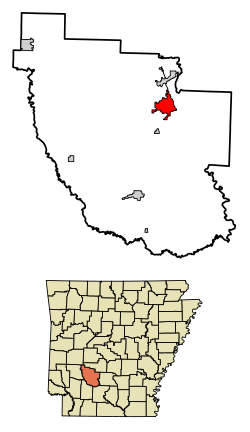Arkadelphia, Arkansas | |
|---|---|
| City of Arkadelphia | |
 Downtown Arkadelphia | |
| Etymology: Greek for "Brother of Arkansas" | |
 Location of Arkadelphia in Clark County, Arkansas. | |
| Coordinates: 34°7′19″N93°3′58″W / 34.12194°N 93.06611°W | |
| Country | |
| State | |
| County | Clark |
| Township | Caddo |
| Government | |
| • Type | City manager |
| Area | |
• Total | 7.74 sq mi (20.03 km2) |
| • Land | 7.73 sq mi (20.02 km2) |
| • Water | 0.01 sq mi (0.02 km2) |
| Elevation | 246 ft (75 m) |
| Population (2020) | |
• Total | 10,380 |
| • Density | 1,343.17/sq mi (518.60/km2) |
| Time zone | UTC−6 (Central (CST)) |
| • Summer (DST) | UTC−5 (CDT) |
| ZIP Codes | 71923, 71998–71999 |
| Area code | 870 |
| FIPS code | 05-01870 |
| GNIS feature ID | 0076188 |
| Website | cityofarkadelphia |
Arkadelphia is a city in Clark County, Arkansas, United States. As of the 2020 census, the population was 10,380. [2] The city is the county seat of Clark County. [3] It is situated at the foothills of the Ouachita Mountains. Two universities, Henderson State University and Ouachita Baptist University, are located here. Arkadelphia was incorporated in 1857.
Contents
- History
- Geography
- Climate
- Demographics
- 2020 census
- 2010 census
- 2000 census
- Economy
- Arts and culture
- Tourism
- Parks and recreation
- Government
- Education
- Colleges and universities
- Secondary schools
- Historic schools
- Infrastructure
- Healthcare
- Transportation
- Utilities
- Notable people
- See also
- References
- External links








